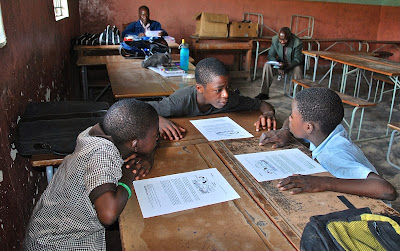We began our day at Matero, a school I have visited
often. They have a large
pre-school program with two teachers and about 75 children. Even though I am not working with
pre-school teachers this trip I had to stop by and greet my old friends Rabecca and Peggy before visiting the grades one through six.
The teacher who has been teaching grades 1 – 4 for many
years (Fanley) got married and moved to another city with her husband. Two new teachers are now at Matero who
have some experience teaching in private schools. James teaches the grade one and two class and Patrick the
grades three – six class.
I taught
my lesson on parts of the plant to the grades one and two and began by having them draw a plant
outside. Students are not asked to draw from real life - only from diagrams on the chalkboard. It is always a challenge to get them started but they seemed to enjoy it once they found their confidence. When we got back inside and I started asking questions I noticed the students did not know how to turn and talk to their neighbors for ideas. The first several questions were met with blank stares.
Once the students warmed up to the idea that they could ask their
partner for help the discussion started flowing more freely. Assessing the level of difficulty of this lesson and how much the grade one and twos struggled to learn the words flower, leaf, stem and roots as parts of the plant, I decided to adjust my planned lesson and teach my Zambian Flag
lesson to the older students in hopes that it would be the correct level of difficulty.
 |
| Students share with a partner and raise their hands in agreement |
 |
| My crude drawing of the Zambia flag serves as a model |
Again turning and talking was a new concept and
students reluctantly
asked their neighbors for help but eventually they joined in the discussion
readily. After a good understanding of the flag colors and what the represent, the eagle and its symbolism, and where each is located in relationship to a rectangle,
the students were off and running on their drawings.
When I asked the teachers what they noticed they commented
that I asked a lot of questions.
The teachers yesterday made the same comment. Yesterday I only acknowledged this thinking that was an
obvious observation and asked them, "what else?" Today I realized they commented on this because students are
not asked a lot of questions, they are simply told the content, asked to copy
it off the board and at best fill in the blanks to assess their knowledge. They are never allowed to talk to their
neighbor or think for themselves. I should have remembered this is the traditional way of teaching. I guess I was hoping that times have changed and this is no longer the practice. I reminded the teachers the importance of
getting the students to think for themselves and the power of discussing ideas with their classmates. Teaching is not telling the answers
but allowing students ways to make connections with the concepts so they can remember and apply the learning.
Our next stop was Mandevu. I have worked with Mandevu since 2011. Some of the best teachers used to teach
there. In 2012 I did some intensive work with engagement strategies - modeling,
observing, and giving feedback for a week in that school. It really made a difference for student learning. Unfortunately all the
teachers from that time have moved on to other schools and many of the students moved with their
teachers. The enrollment is down to 10 - 15 students per class. So today while introducing my lesson and asking questions I received blank stares. This was partly because I
“talk funny” and “look funny.” My
accent is so different from Zambian English and students rarely see a white
person, especially an older white haired, white woman that the combination of
the language, my appearance and a new teacher was quite a distraction from the learning. Also
asking students to think, infer, and question why, is just not done here. I did get some productive discussion with the grade sevens about the water cycle.
During the wrap up all the teachers commented on
the power of asking students questions and having them discuss the answers with
their neighbor. They want to practice “turn and talk” or “think pair share”
before I come back next Friday to observe their lessons. We also discussed the importance of
speaking more English. I reminded the teachers of the two things that will help
these children move out of poverty – the ability to speak English and the ability to
think and problem solve.
The day ended with a visit from my friend Dr. Chilenje who
wanted to interview me for a paper he is writing on religion and society. As usual he asked me many thought
provoking questions such, “What is the purpose of religion in society?” I’m not an expert on the topic but I am
happy to share my opinions. He is collecting
interviews from 10 – 15 people such as judges, ministers, government officials,
professors and this educator for his paper. I was humbled to be included with such an impressive
group. I am interested to read the
paper when he finishes.









No comments:
Post a Comment